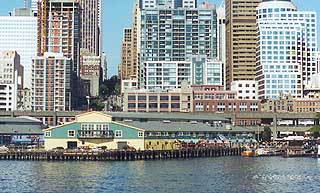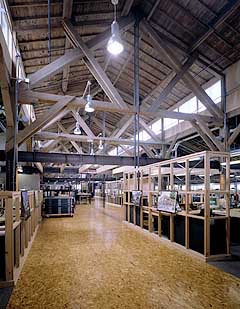|
Subscribe / Renew |
|
|
Contact Us |
|
| ► Subscribe to our Free Weekly Newsletter | |
| home | Welcome, sign in or click here to subscribe. | login |
Construction
| |
 |
October 12, 2000
Not imitating can be sincere flattery, too
Mithun
What is the first thing you do when you move into a historic pier on Seattle’s downtown waterfront? Look up…Marvel at the beauty of the original structure and wonder what stories the building could tell.

|
Built in 1900, Pier 56 has a rich history, from its construction to support the burgeoning Pacific trade and Klondike Gold Rush, home of the Seattle Marine Aquarium and its contentious killer whale exhibit, a warehouse space and practice facility for the Seattle band The Retros.
In April of this year, Mithun Architects + Designers + Planners completed renovation of the historic pier and moved its offices into the entire second floor. Balancing the needs of a modern business committed to sustainable building practices with the inherent beauty of a historic structure, provided some uncommon opportunities to create a contemporary design while also restoring and retaining those original structural elements which make the space unique.
“The concept is an appropriate and modern response to historic renovation. Rather than be nostalgic and try to imitate what was already existing, we consciously designed the elements of the office space to be clearly new and to contrast the restored timber structure,” explains Steve Bull, a Mithun associate and project designer for Pier 56.
To do this and to emphasize the distinctive materials and linear spatial experience of the original warehouse, all the interior walls that did not enclose mechanical or electrical rooms were removed. This created an open office neighborhood for employees, clients and visitors. The roof was insulated on the exterior allowing the rafters to remain exposed. Then the original timber structure was sandblasted to bring back the aura of the early 1900’s.
Being a central figure of Seattle’s historical character district, Pier 56 had some conditions on its roofline which influenced design decisions. Mithun removed the old elevator “doghouse” from the roof that was a product of an earlier renovation, returning it to it original form. In the clerestory on the south and north sides new operable windows that respect the scale and proportion of the pier’s historical character were added. At the office level the windows include six foot square lites that emphasize the proportion and locations of the original cargo doors.
Within the office, required private spaces were thought of as vessels. “These vessels are autonomous forms where the space inside is distinctly different from that which surrounds it. It does not interfere with the experience of the historic space or engage the existing structure. Their saturated colors contrast the dominant wood columns, trusses and ceiling joists,” says Bull.
Also treated as a vessel, the entry space separates the busy tourism-focused context from the aura of the old warehouse office space. To emphasize its autonomy, the entry vessel is situated behind the historic façade into which broad openings have been cut to allow for access. After climbing a steel stair reminiscent of old warehouse spaces, the visitor emerges from this distinct transition space directly into the full volume of the old timber warehouse and office space.
Exterior changes to Pier 56 were more conservative, apart from those things that are unique to buildings above water. The famous yellow color was changed to make it a little more lively, but it still plays a part by balancing the new green color. More important was the integrity of the building and the pilings. Over 100 years on salt water had taken its toll. The effects of dry rot required that the beams and columns on the southwest end of the building be rebuilt and several pilings were replaced with new steel pilings.
Reconstructing History
“The most impressive thing for the carpenters was a true appreciation for the truss and floor system,” says Gary Clark senior project manager for Edifice Construction. The structure itself is 100 feet wide and 400 feet long, with 36,000 square feet on each of its two floors. Given the era that the building was constructed and the tools that were available, the engineering system of the entire structure is impressive. For instance, the beams were likely hand hewn at a 45 degree angle, “amazing considering the size of the beams and the technology available,” says Clark.

|
The integrity of the structure nearly 100 years later is equally as amazing. Although the building had settled over the years, creating a six inch difference between the start and end of the west third of the building, the structure itself was sound enough to require very little structural reconstruction. Most challenges centered around the materials and finishes that were required by Mithun’s commitment to sustainable building practices and the fact that the interior construction was occurring simultaneously with the exterior.
The particle board flooring, known as oriented strand board (OSB) was adhered with a moisture-sensitive, low-toxicity glue. However, given that the exterior was not completely closed in when the flooring was being installed, the moisture from Puget Sound facilitated the thickening and setting of the glue, making it very difficult to spread. A laborer could not work more than eight hours at a time with the glue because it was so hard to spread, according to Clark. “We actually placed the glue in an enclosed area with heaters to keep the glue from activating.”
Special care was also necessary with the low-VOC paints that were used. Because the paint does not set well in areas with moisture, the rooms that were painted had to be enclosed in large plastic tents with heaters for days at a time to prevent a “milky” appearance when completely dried.
“Overall, even though there were some challenges, I am excited that companies are focusing more on sustainable building practices more often, it’s better for everyone involved and the environment,” says Clark.
Mickey Smith of Martin Smith, owners and managers of Pier 56 and several other historic Seattle properties believes, “It is important to retain the historic character and flavor of our Seattle landmarks, while also making them adaptable to the modern business.” The renovations completed by Mithun will carry the history and modernity of Pier 56 well into the future.
Kipepeo Brown is an associate with Seattle-based Mithun.
Other Stories:
- Renovations bring boom times back to Pioneer Square
- New research can help building owners who are shaken up by quake hazards
- Building moves to head of its class


